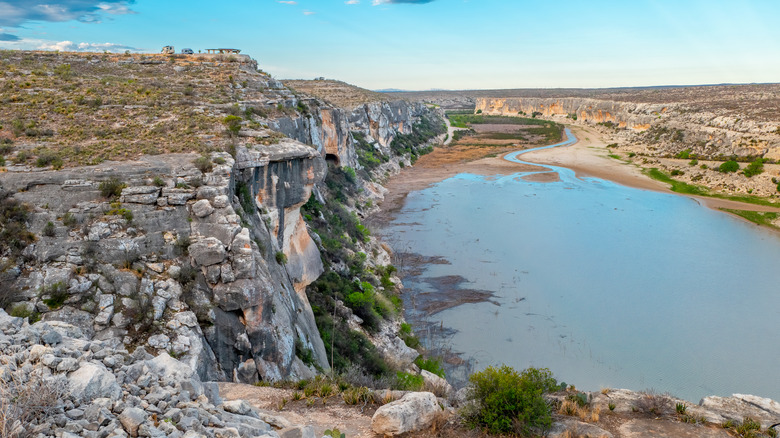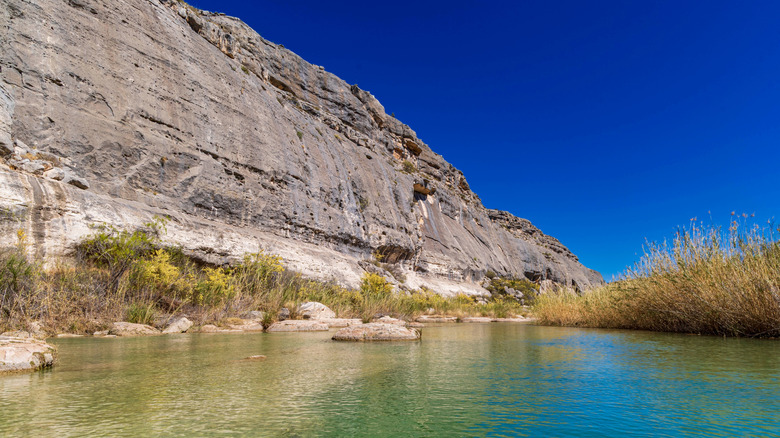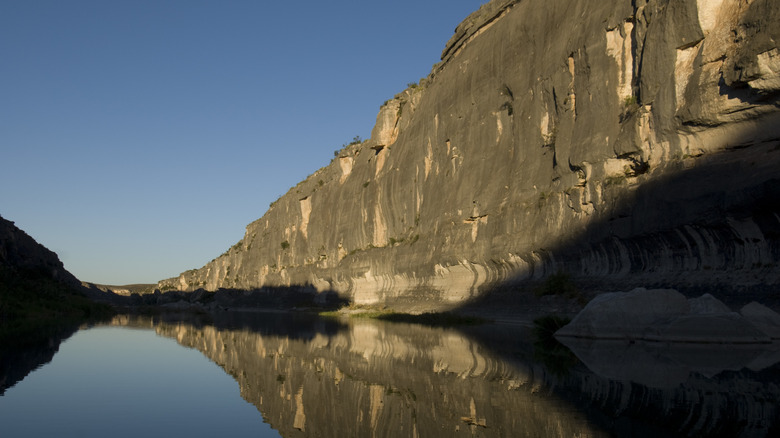Texas' Most Incredible Bright Blue River Is A Recreation Paradise Winding Through Canyons And Mountains
Rivers, much like people, can contain multitudes. An unassuming stream may transform into an unruly whitewater tempest, while a flat, modest shoreline rises to become imposing canyons. Texas's stretch of the Pecos River contains these multitudes and more, creating a rugged paradise that's simultaneously all-consuming and yet remote. Its revelations include incredible canyons and mountains imposing themselves over a bright blue river, turning a vacation here into a transformative multi-day trip ideal for the hardiest of travelers.
Seasoned sightseers may already recognize the Pecos from its cameo along the undeniably charming New Mexico byway, the High Road to Taos. The river begins in Mora County, New Mexico, then traverses across two states before connecting with the Rio Grande in Texas. There, its flat landscape gives way to domineering stone facades, becoming an abrasive desert escape that leaves visitors feeling insignificant. And that's the point — a journey down the Pecos River mixes awe and peril in equal doses, with a renewed sense of vigor and purpose refreshing visitors as they leave.
Traverse the Pecos River and test yourself
Consider the Pecos River a one-way destination, especially for kayakers and rafters. Once you enter the water at Pandale, Texas, and head toward the Amistad Reservoir, there's no going back. The waterway unfurls, carrying you along the rocky terrain carved by centuries of erosion. You'll swap reedy waters with hard-to-see runs, hidden by an invasive plant known as "cane," with an imposing canyon approaching in the distance. Flash flooding remains a constant threat. Choosing a campsite is dicey.
Legally, you're allowed to camp on islands or the flat rocks lining the river's banks, yet most land along the river is privately owned, so an ornery local may tell you to scram, with varying degrees of politeness. Outfitters are rare; you're mostly on your own for close to 60 miles of unforgiving travel down Class II and III rapids. The U.S. Border Patrol is the only agency with complete access to the river, should things go downhill. Even the water's alkalinity makes taking a sip dangerous. Your gear will suffer, and so will your body. It all makes one wonder why the hell you'd ever visit in the first place.
Hardy adventurers find that it's all worth it. The river transforms from a slothful pace to challenging rapids. The bright blue and turquoise expanse before you turns into crystal-clear water as it passes below. Wildlife, from owls to white-tailed deer, traverse the rocky terrain around you. Along the way, you'll find petroglyphs left behind by ancient peoples, a reminder that the Pecos River's stretch of canyons was the epicenter of Native American societies for centuries. You'll cast a line and try to catch some non-native rainbow and brown trout. Near the end, surrounded by majestic canyons, you can hightail out close to the Weir Dam, then unwind in Langtry, a unique town right by the Rio Grande packed with desert charm and quirky attractions.
The trying logistics of reaching the Pecos River
Pandale, Texas, where you should start your journey down the Pecos River, is, to put it mildly, remote. San Antonio International Airport is the nearest major travel hub, about 250 miles (a four-hour drive) away. Smaller airports nearby like San Angelo or Midland International can cut your drive time down significantly, but at the expense of additional logistical headaches.
You'll likely want to rest when you first arrive, and Ozona offers your best bet. Stays at local inns cost about $100 a night as of this writing and leave you an hour's drive away from the river. If you're looking for a more luxurious, easier entry, head over to the Pandale Crossing River Resort, which is a little farther downriver and offers cabins stocked with all modern conveniences. But once you're on the river, your accommodations consist solely of whatever you've packed.
Texas's sweltering summer and the natural undulation of the waters make spring and late fall the ideal times to visit. Before you go, check the river's levels and flow. If it's too low, you'll spend most of your trip dragging your kayak or canoe; too high, and you'll be fighting to keep steady and upright in the floodwaters. Pack light and bring the bare essentials: water and filters, camping gear, a satellite communications gadget, and a spare paddle. If you make it all the way to Comstock, Texas, head over to Seminole Canyon State Park and Historic Site, which boasts impressive views without the crowds you'll find at other state parks.


